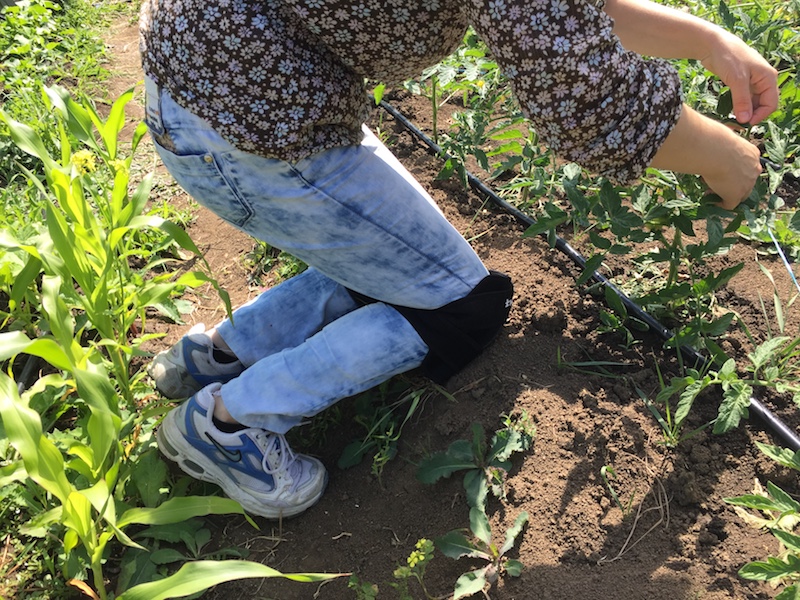Are you a happy inhabitant of city that never sleeps? Or live in a sunny Miami? Are you from Oklahoma? Do you live in Washington? Wherever you live, you surely can buy any vegetables and greens you want — thanks to rapidly-developing economy of the United States, local farmers have great possibilities to deliver fresh and high-quality products to any state and city in the country.
However, there is still a problem and when it comes to herbs, it is hard to neglect sometimes it takes hours to find them, to find exactly the ones you need.
Moreover, to emphasize on their freshness, not all supermarkets and stores are ready to offer you just-from-a-local-garden herbs. In addition, you can freely buy almost any herbs in summer, but what if you don’t live in a sunny state? Yes, you have to overpay for herbs and vegetables planted somewhere on the other end of the country.
The last but not the least reason is that sometimes they can content nitrates and during storage does not make any good.
If you want to get as much vitamins as possible with less efforts, you will surely like our idea. Let us make herb-garden on your window sill! Sounds newly for you? Don’t worry since we have prepared step-by-step tutorial to make a nice and cool garden in several hours.
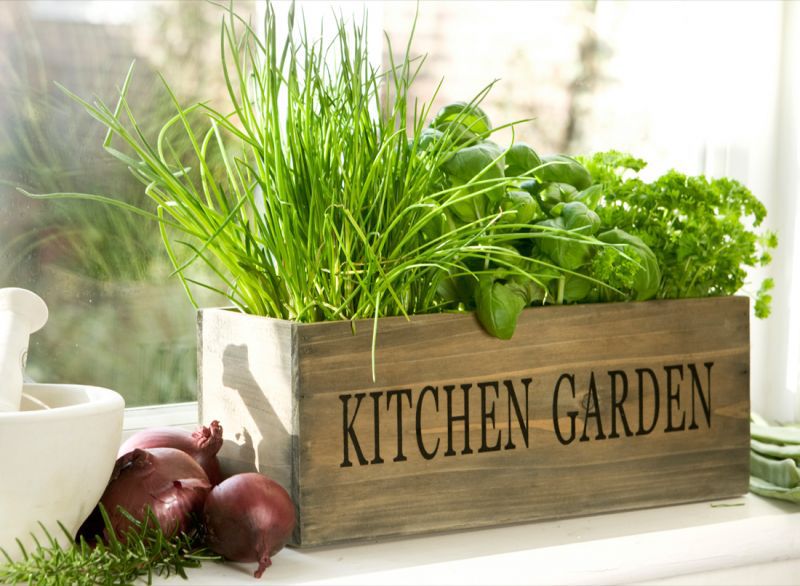
You will learn how to make your own bed, plant seeds and take care of herbs. This opportunity has many advantages. First, your own herb-garden is a possibility to have herbs for salads or any other meals whenever you want. Seconds, it will literally save you hundreds of dollars. The other advantage is that you are sure that all herbs in your window sill garden are natural and any consistence of nitrates is impossible.
You will need seeds, containers to plant your herbs and vegetables, soil and drainage.
LET US STOP AND TALK ABOUT THESE TOOLS IN DETAILS:
- Speaking about seeds, we recommend to buy them online or at local farmers’. Make sure you have chosen a decent company you can rely on and they supply with high-quality seeds.
- As for containers, it will be more convenient to get horizontal containers, however, you can also grow herbs and small vegetables in pots. It is up to you.
- Speaking about soil, you can choose all-purpose products or ones which are aimed for herbs and flowers.
- Drainage does not matter; you can choose any producer; just pay attention its size fits pots or containers you are going to use for your window sill garden.
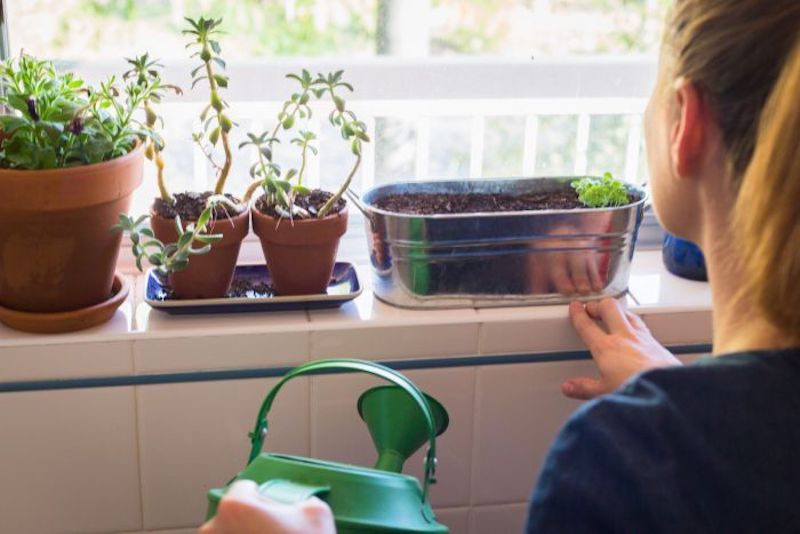
Important Tips to Make Herb-Garden of your Dreams
As you have already understood, gardening is not that hard, however, paying much attention to each element of the process is a must.
Starting with dilemma — containers on a windowsill or yard — don’t worry since herbs and small vegetables like cherry tomatoes are much easier to grow than flowers or big vegetables we usually grow in a garden.
All you need is a wide window sill to put your herbs without any risks to fall down. Sunny patios are also great for gardening, so if you live in a sunny state and have such a nice possibility to grow your own herb-garden somewhere on the patio, don’t refuse it.
By growing vegetables in container, you have numerous advantages: no need to dig the grown very deep, no need to check it since you buy soil, no need to worry about drainage since you buy it too.
Do you have an opportunity to grow herbs in your own garden? In this case, you can set an experiment and make sure if you treat your herbs well, they will even better grow indoors than outdoors.
Speaking about size, some plants are big and we recommend to grow them in a separate pot. Below you will find out more about how much space each herb need to feel comfy and deliver much harvest.

How to Start An Herb Garden on A Window Sill — 5 steps
Before you start making your herb garden, we want you to know that this process is not so complicated or you have to learn biology from A to Z to grow your herb garden.
However, it is critically important to know some rules to plant seeds correctly and get harvest in 1-2 months.
- First of all, keep in mind any small vegetables and herbs are very easy to grow with a little sunshine, that’s why choose a sill which can meet this requirement.
- The second condition for a nice herb garden is soil which drains well. As it was mentioned before, both soil and drainage are important.
- The next thing you have to remember about is watering — some herbs require frequent watering and some of them are good with watering only once a week.
- In addition, some compost is always a good idea and if you can buy a little fertilizer for your herbs — do it.
The one and only recommendation here is not to overdose it. As you have already found out, herbs and vegetables could be grown in pots or plastic containers, however, you should not forget these plants prefer to be in the soil where they can easily spread out. That is why size matters much more than material — 4-6 feet is optimal width and length.
Make sure you don’t get your plants stressed and they will result in rich harvest.
Let us talk about the abovementioned recommendations in details.
Step 1.
Location, location, location.
The main requirement of organizing a nice herb-garden which brings much harvest is to grow herbs in the right place. There is a well-spread myth full sun places (where temperature can easily rise above 45 C) are good for herbs. It is not right since very warm summers and high temperatures will simply burn your plants.
Consider planting your herbs where they will get morning or afternoon sun.
Another option is to place herbs and vegetables where they receive filtered light (for instance, through a light curtain on a window).
To make sure you have chosen the perfect place for your garden, check plants during one day to understand if this location and its sun hours suits them.
Step 2.
Planting herbs and vegetables.
For planning vegetables and herbs, you will have to measure pots. For each plant you will need up to 4 feet.
For instance, for cherry tomatoes you will need 4 feet as well as for sage, mints and oregano. 2 feet is enough for thyme, tarragon, savory. Speaking about cilantro, dill and parsley — 1 feet is more than enough here.
When measuring your pot or container to plant herbs, make sure you have calculated width, length and height.
Sometimes garden-lovers buy wide containers, but they are not that long or on the contrary.
Step 3.
It is time to prepare drainage and soil.
Now you have to prepare drainage and soil for your herbs. This tandem is a foundation for your garden and the better you prepare it, the more harvest you will have.
Divide the height of your pot for 3 and put 1/3 drainage inside. Now take some soil and put it inside — ½ of your container must be filled. This system allows water to drain and provides needed space for herbs’ plants.
We also recommend to use a simple fork and dig soil a bit since it will make lighter which will result in better ecosystem for your plants.
Keep in mind that this is the most important thing in the whole process of making your own garden on a window sill — if you don’t use drainage, don’t dig soil or mix soil with drainage, you will have problems and possible risks with harvest.
Since everybody wants to grow strong, healthy vegetables and herbs, we recommend to follow these rules.
Step 4.
Planting Herbs.
The process of planting is easier than preparations to it.
You have to make a small row or deepening (depends on where you are going to plant your herbs) and put seeds into it.
Make sure you provide enough space for each future herb.
When you are done, simply pour some soil onto it and that is it.
Step 5.
Watering.
Now watering. The majority of herbs and small vegetables like to be watered very often and if you notice the soil is dry to the touch, it is time to water your herb-garden.
As temperatures and humidity differ in each state, drying can cause even more serious problems and vary every week.
That is why it would be nice to buy a special tool to measure it and keep a finger on a pulse.
But avoid overwatering. It is hard to choose between too dry soil and overwatered, however, the latter simply kills your herbs since they cannot breath or it may result in significantly reduced growth.
We recommend to buy a watering can since some herbs cannot be watered “just like that” and a strong spurt can simply injure them.
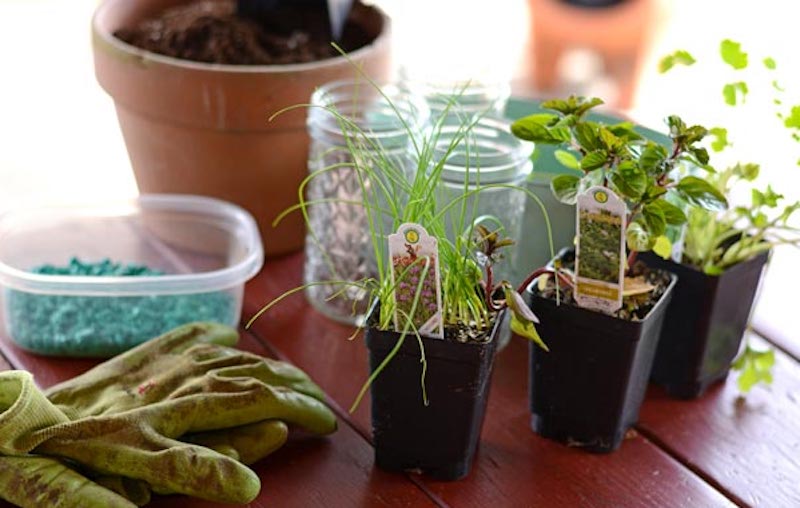
TOP Popular Herbs to Plant on Your Window Sill
Dill.
As well as the majority of herbs, dill loves water, however, it also likes super-hot weather which is not good for the rest of herbs. Keep in mind that without sufficient watering, thin leaves can be simply overwhelmed. If you are going to plant a dill, you should know he loves light and much fresh air. Its seeds do not always rise well, that is why it is recommended to pre-soak them for a few days in a warm water, which should be changed periodically. A good thing about dill is that once you have planted it, you will see the first results in a month.
Parsley.
Its seeds are also recommended to pre-soak in water. Speaking about rules of planting and growing this herb, they are pretty the same as drill’s however, it claims calmed down temperature and feels better outdoors so you should probably open the window more often or plant parsley on the balcony, terrace or loggia.
Basil.
One of the most favorite herbs ever! It perfectly tastes with meat, fish and salads. Unlike parsley, basic is susceptible to temperature changes, so it feels good on the balcony only in the summer, the rest of the time it’s better to keep it in the room on the windowsill. As well as dill, it will bring you harvest only in a month.
Melissa or lemon balm.
Easy-to-grow and aromatic, this herb should be planted in a moist soil and believe us, in this case it will appear very soon.
Mint Pepper.
This one is more whimsical than lemon balm. Its seeds do not always ripen, so with great success it is being propagated vegetative. Mint is in a great demand of high-quality soil and needs regular watering. In addition, it does not tolerate any temperature changes, that is why it is better to grow it indoors on a “warm” window sill.
Cress salad.
If you want to get harvest quickly, choose salad! Plant seeds in moist soil and water regularly (3 times a week). This salad does not like heat and long exposure to sunlight. Two weeks after planting the seeds, you can harvest the first crop.
Chinese cabbage.
Due to the fact that Beijing cabbage does not lack illumination, it can be grown on the windowsill even in the cold season. Put some ask or chalk into soil to make sure it is not acidic. Seeds are sown to a depth of 0.5 cm and covered with a food film wrap. When there are shoots, the food film is removed, and the pot should be put on the window. Your harvest can be removed in a month.
Spinach.
Spinach seeds are planted in a row in moist soil and when the first pair of leaves appear, pluck the weakest ones. Spinach loves moisture, because without watering its leaves coarsen. Harvest will be in three to four weeks.
Sorrel.
As well as many other herbs and vegetables, it can be planted in a pot or a container. It is recommended to out its seeds into water for 3-4 days, changing it from time to time. You can also cover it with a food film wrap once you have planted seeds and delete it when the first shoots appear. Remove it and put pot on a bright sill. Sorrel is unpretentious, this herb grows in any soil, but require regular watering.
Lemon.
Even though it is not herb or vegetable, it is easy to grow a lemon on a window sill. Make sure there is enough space for this fruit and it gets enough non-direct sun light.
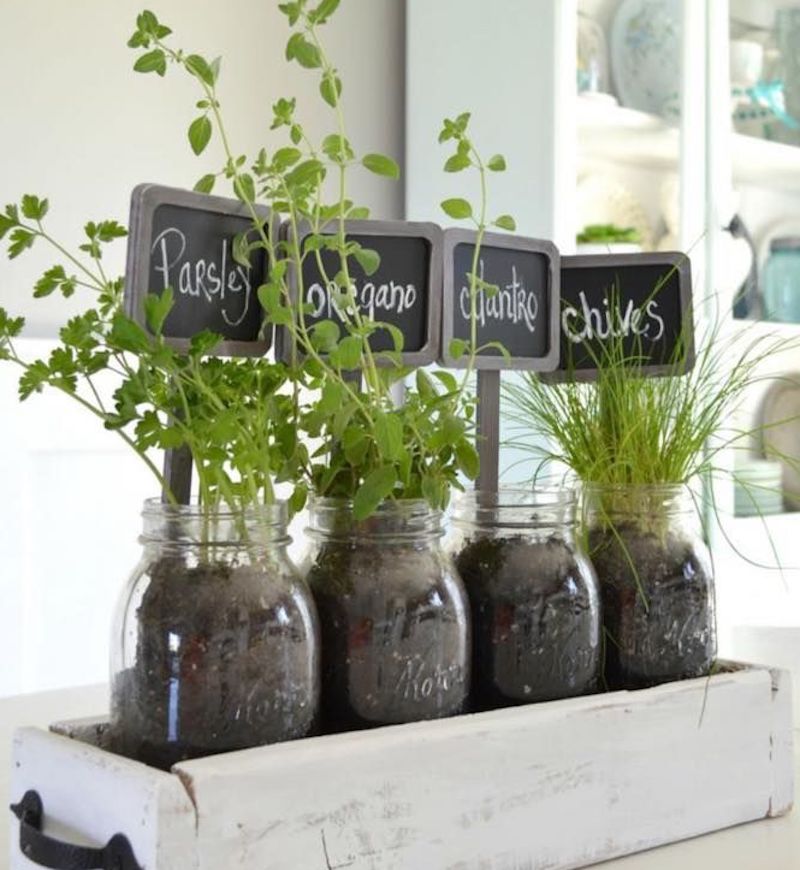
How to Make Herb-Garden on Your Window Sill — Bonus:
Compost and Fertilizer.
When it comes to composts and fertilizers, people are usually divided into two groups. The first one claims herbs and small vegetables either do not need it or it could make much harm for one’s health. The other party is sure fertilizer is a must, especially if you want to grow healthy herbs.
We tend to gold measure. Look for organic composts and fertilizers on the Internet and add them to water to add it to your herbs.
Transplantation.
You may surely want to transplant some herbs to larger containers in the future and it is normal since they can outgrow from time to time. For example, basils can easily grow to over 45 cm. high. To transplant your herbs, prepare container. You have to fill it with high-quality drainage and soil. It would be nice to add some fertilizer, but mind instruction and always read it not to overdose.
Now when you are done with drainage and soil, water it until you feel that soil feels damp all the way through. By the way, it is better to do both planting and transportation on the floor. We recommend to put old newspapers and organize transportation on it.
In addition, since you will be standing on your knees at least 2-3 hours, we strongly recommend to put some protection. For example, soft and reliable knee pads will save your knees and make you able to stand planting or do transplantation of your herbs for many hours.
Now when you have protected the floor and most importantly, your knees, you are ready to plant. You have to dig large holes for each plant or vegetable. Gently release your herbs from the previous pots or containers. Three easy steps: turn your pot upside down and tap it several times. That is it. Now you have to pull out the base of the herb and the plant will come out easily. Note that you do not have to tap too fast or strong.
We recommend to water a plant and then try these easy steps one more time. Once you are done, place the herb into the prepared hole and gently press so it will dig into soil. Pour soil to “close” edges and fill gaps besides the herb.
When it comes to water, it goes without saying it is needed once you have planted herbs: water them profusely, but do not over-water them. Both over- and under-watering are not good for herbs and vegetables.
Transplanted herbs have to get at least 3 hours of sunshine a day, but remember they don’t like direct sun light as well as just-seeded plants.
Harvesting! To gather harvest, you have been growing months, simply cut some branches when herbs not less than 20-30 cm. in height. In comparison with other plants, the best thing about herbs is that the more you cut off them, the better they regrow.
For instance, some of them (live parsley) do not regrow, but grow a new leave. Thus, you will have to remove old branches and leave just new tiny ones. Even though it may seem not that clear, it becomes obvious when you practice growing your herbs and vegetables.
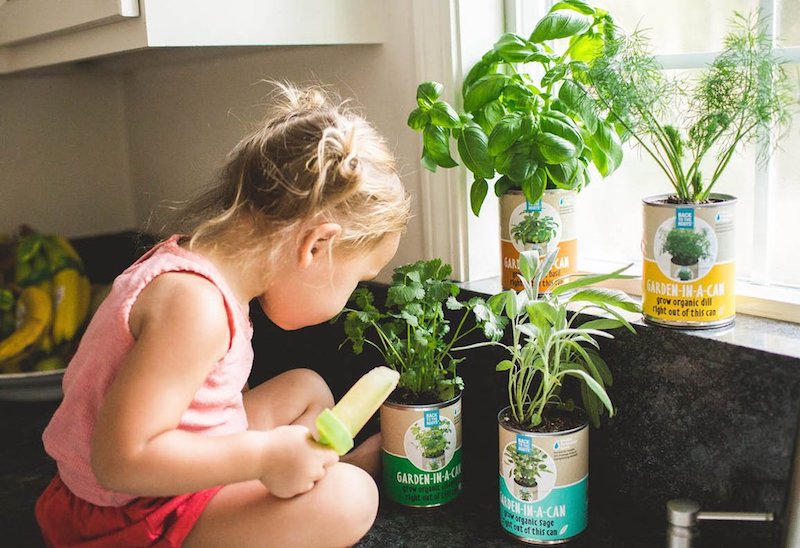
Good luck! Try to plant seeds in a good mood, with love, because it’s even more important than sticking to the lunar calendar!
